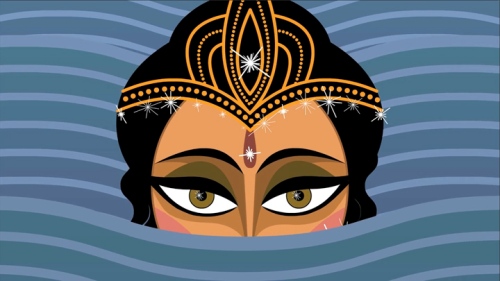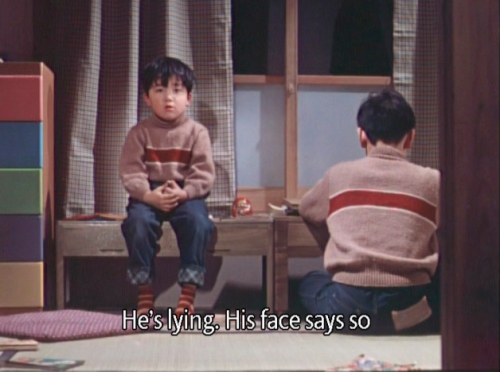I recently watched three very different documentaries:
Andrew Gurland and Todd Phillips’ Frat House (’98),
Adi Sideman’s Chicken Hawk (’94), and
Tony Kaye’s Lake of Fire (’06)
Though probably best known for frat-flick Old School, Todd Phillips is a former maverick documentarian whose earliest work, Hated: G. G. Allin and the Murder Junkies, has received its definite share of cult praise (and once stood as NYU’s highest-grossing film made by an undergrad). Frat House is Phillps’ follow-up, this time with Alex Gurland, exploring the dedicated, secretive hazing and initiation rituals practiced by certain North American college fraternities. Though some remain anonymous in the film, the exposed fraternities include most largely Alpha Tau Omega of PA’s Muhlenberg College, and Beta Chi of New York College’s Oneonta campus.
Originally produced for the frequently interesting HBO docu-series, America Undercover, the film won the Grand Jury Prize for Documentary at the 1998 Sundance Film Festival. But controversy quickly followed, including allegations of staged scenes, reenactments and other less-than-spontaneous content. Alpha Tau Omega’s national organizers launched responsive legal efforts that ultimately led to HBO’s decision to not air the film. Though the filmmakers have always asserted the accuracy of their film, it has since fallen into obscurity.
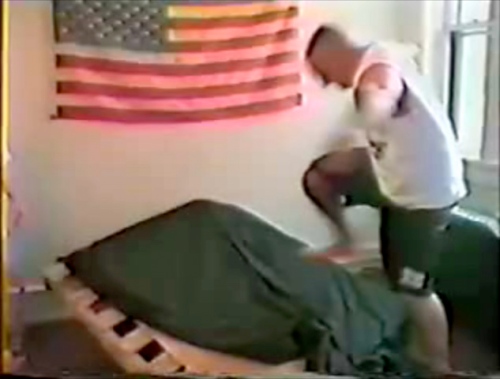
During an interview, the frat brother known as "Blossom" is shown attacking and destroying a wooden transport palette.
Despite all validity in the argument that most documentaries are to some degree ‘staged,’ the film did feel strangely manufactured upon a first viewing (even though I knew nothing of its challenged realism beforehand). Even still, the neat-and-tidy structure of the piece may have less to do with potentially fabricated content and more with its originally intended format: an hour-long tv program. The mere all-access nature of the film perhaps suggests a combination of the two. Viewers may wonder in retrospect, if Old School‘s fictional lampooning of fraternity life was Phillips’ intention even in this earlier work.
Years before Frat House, Phillips and Gurland founded the New York Underground Film Festival which, during its first proceedings in 1994, premiered Adi Sidemen’s reluctantly sinister Chicken Hawk: Men Who Love Boys. The film’s subjects — many of whom are associated with the bi-coastal fringe organization NAMBLA (North American Man/Boy Love Association) — are completely ensorcelled by underage boys, with most of them devotedly unapologetic of it despite age-of-consent laws and shunning by the larger gay rights movement.
Though its depiction hopes to remain mostly unbiased, the film allows the men a few brief, vaguely sympathetic if pitying moments. Regardless, it’s difficult to imagine even the most open-minded viewers conjuring even distant personal approval of these subjects, for the skewed earnestness and common ‘love’ these aging individuals share for male youth (whom, they argue, are consenting) is clearly too obsessive to be anything “transcendental” (as described by one interviewee), or simply misunderstood.
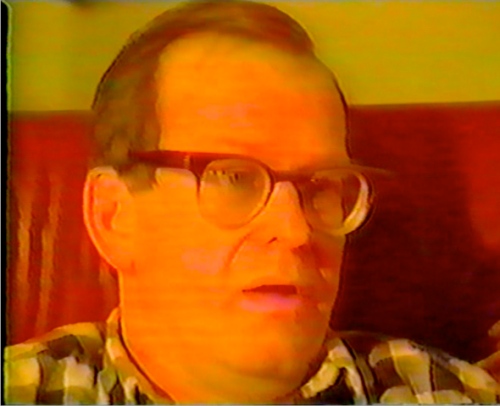
This guy kinda says it all.
Where the first two films mostly maintain a conventional documentary style structurally, in their visual reporting, and with both sharing an hour-long running time, Tony Kaye’s Lake of Fire is almost their antithesis. Sixteen years in the making and filmed entirely in emotionally arresting black-and-white, it is a sprawling 152-minute rumination on the protean abortion debate in America.
The film is near-definitive in its collective analysis and display of a single nation extremely divided on the issue of abortion, uncovering its blurry, circular and endlessly complex moral implications. It presents a multitude of interviews ranging from religious fundamentalists, activists on both sides (including Norma McCorvey, a.k.a. “Jane Roe”), to regarded thinkers like Noam Chomsky. These scenes are balanced — sometimes unevenly — with footage of clinic protests and pro-choice escorts, religious rallies, and archival news footage and interviews with imprisoned ‘abortionist’ murderers.
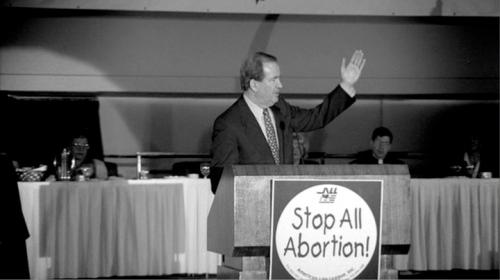
Pat Buchanan at a gathering of the American Life League.
Most sobering however, is Kaye’s unflinching inclusion of the procedure itself, shot over the shoulder of the operating physician, at an angle not even seen by the patient herself. Then, just above his gloved hands in an indiscriminate close-up, we must watch as the practitioner reassembles the unmistakably human fetal remains into a whole, to make certain that nothing was left inside.
Nearly a decade before Lake‘s completion, Kaye was involved in another controversy regarding his first and only narrative feature, 1998’s American History X. Claiming that Ed Norton re-edited the film to give himself more screen time, Kaye (unhappy with the final cut) attempted to remain uncredited as the film’s director, but was unsuccessful due to a Directors’ Guild technicality.
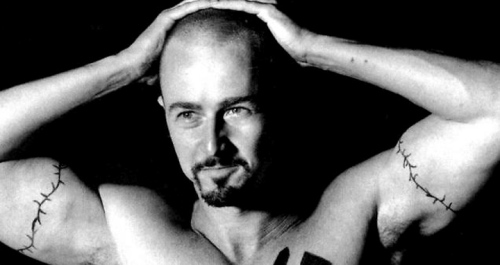
Both "Lake of Fire" and (moments of) "American History X" are captured in symbolic monotone.
Still, the two films bear definite similarities, namely in their dramatic use of black-and-white imagery and their accompanying over-dramatic scores. The most unfortunate side effect of Lake of Fire‘s baroque motif (its title referring to damnation, as described in The Book of Revelation) is Anne Dudley’s imposing, histrionic score. Not only do these musical points cause the work to feel even longer than it already is, but of all assuredly morose issues a filmmaker can address, abortion (and all its related visuals) is one that certainly doesn’t require such an obvious and constant reminder of its emotional nature.
Though, in spite of this nagging element, Kaye’s long-term filmmaking project is certainly a cultural achievement. Perhaps more unfortunate is that Lake of Fire failed to receive official Oscar attention, with three of the five nominated films that year relating to the U.S. involvement in either Iraq or Afghanistan.
- A low-quality, but watchable version of Frat House can be viewed here.
- Chicken Hawk can be viewed in six parts, beginning here.
- Lake of Fire is widely available, and is distributed by ThinkFilm.
Additional Suggested Viewing | Documentary:
